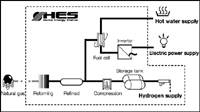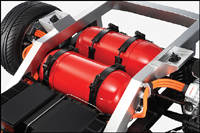Honda Advances the Hydrogen DreamSeveral months ago at the Tokyo Motor Show, Honda introduced a
 |
| One day, we'll all be driving cars that are as cool-looking and green as the FCX. That day could be sooner than you think. (Photo: American Honda) |
wind cheating, earth friendly, fuel cell-powered concept called the FCX. Several weeks ago in Detroit at the NAIAS, Honda quietly announced that they would build a production vehicle based on the FCX concept. With the advancements they've made for this latest generation of hydrogen-powered fuel cell vehicles, a production model will be ready within three to four years. It will probably be available only to a small group of alternative fuel loyalists and devotees, and likely only in Japan or possibly California where Honda previously introduced the FCX-V4 of which a portion of 30 examples found their way into government fleets (see new vehicle preview section of this website for January 16, 2003: 2003 Honda FCX-V4 Preview) and at least one famiy (see automotive news section of this website for July 3, 2005: Honda Tests Hydrogen-Powered FCX with Private Family for First Time), but the packaging solutions Honda has developed for hydrogen storage as well as their clever Home Energy Station, alleviating the need for widespread hydrogen refilling stations on the road, point the way around many of the obstacles, or detours, on the road to the hydrogen highway and zero-emission culture of the future.
Many
 |
| V-Flow fuel cell platform is the backbone to the FCX. (Photo: American Honda) |
of the advancements with the new FCX center around Honda's V Flow fuel cell platform. The cells are stacked vertically in the center tunnel and arranged in a vertebral layout (think of it as though the stacks are your backbones if you are lying on your back) for higher efficiency packaging as well as more efficient management of gas flow (from top to bottom). Another breakthrough was in the realm of storage, and with a newly developed higher absorption material in the tanks which allowed Honda to double storage capacity. The FCX can achieve a real-world driving range of over 350 miles.
The fuel cells work by collecting energy from the conversion of
 |
| FCX comes with plenty of fine print and diagrams for those with a taste for technical detail (see gallery). (Photo: American Honda) |
hydrogen and oxygen into water, which gives off electricity. In the case of the FCX, the energy is then fed to three efficient motors, two compact 25kW motors in each of the rear wheels and a larger energy-efficient 80kW motor in the front. The three motors combine to make a total of 100kW, and the primary emission is water, which flows through those vertical stacks more easily than the usual horizontal arrangements.
 |
| Low-mounted tanks improve its center of gravity. (Photo: American Honda) |
Another advantage of the V Flow fuel cell's vertical arrangement along the center tunnel is that it frees up huge amounts of space for the interior. The floor is lower and the front dash pushed forward for cavernous space for all passengers, and the low floor also lowers the car's center of gravity, benefiting handling and giving the concept a low-slung space bullet look.
Maybe it's just how low and streamlined the shape of this car is, but it looks long, really long, until you get right next to it and realize it's no longer than your average large sedan; but its profile makes it seem Lamborghini low - perhaps it is, I didn't pull out my tape measure to tell you the truth. It's shape is a definitive tear drop for the top profile, and is just about the most aerodynamic shape achievable for a car, with rear fender spoilers leading into a back deck that also looks like it might provide some extra downforce.






